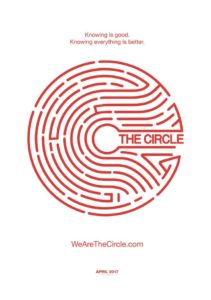Film Review: Melodrama and Loss of Privacy Swirl in The Circle

What cruel mind would object to lowering the occurrence of rape and murder? Or to preventing fatal diseases from developing before they even exist? Or to sharing various experiences that make life worth living with those unable to have such experiences themselves?
Eamon Bailey (Tom Hanks), the charming and enthusiastic executive of the fictional tech company the Circle, raises these questions to an audience of his employees. He’s unveiling the corporation’s latest invention: a tiny, portable camera that can provide not only real-time footage but also “real-time analytic processing.” The device’s utility is at first presented as a way for Bailey to check the tide and swell of local beaches (“I love to surf,” he tells the excited crowd), but it isn’t long before Bailey transitions to its more far-reaching, humanitarian implications. Once SeeChange (the product name for the camera) becomes ubiquitous, he tells his bewitched audience, “tyrants and terrorists can no longer hide.” Bailey has the immaculate charisma of Milton’s devil, and watching Bailey on screen one can’t help but be reminded of the darkest elements of virtue the blind poet captured in his beloved anti-hero: “th’ excess of glory obscured,” “by merit raised to that bad eminence.” He’s the sort of sly seducer that can get people to do evil things by first getting them to laugh.
The Circle (directed by James Ponsoldt) has a different ending [SPOILER ALERT], somehow both glossier and more dystopian, than the 2013 Dave Eggers novel it’s based on. In the novel, similar to Winston Smith’s trajectory in Nineteen Eighty-Four, Mae Holland (played by Emma Watson in the film) betrays her friends and becomes a happy servant to her bosses. In the film, however, she follows through with the plan to undermine the Circle by exposing its executives’ hypocritical stance on privacy. “They want everything in the cloud,” Mae announces at an all-staff meeting, “but they want to live above it.” She then shares with the world the executives’ private emails, revealing—by implication—their authoritarian personalities and intentions.
Hollywood’s impulse for happy endings is likely to blame for the change, although Ponsoldt told Business Insider that he himself worried the original ending might make the audience feel that “Mae is purely evil” and that the central message of the film would be perceived as anti-technology. “I’m not technophobic,” Ponsoldt told his interviewer:
I don’t think technology is inherently bad, I think technology is great. My issue is more with the companies that are bringing us all that great stuff. Why do they have to collect, store, and perhaps monetize our private information? That was the spirit that we wanted to have with the movie and of Emma’s character at the end. She means well, I think, to the very end.
But rather than offer a glimmer of hope, Ponsoldt’s ending reassures the audience that no plausible alternative to technocratic totalitarianism is likely to come. The final scene shows Mae kayaking in the middle of a lake with drones flying overhead. She looks up and flashes them a contented smile.
Nonetheless, the film adaptation of The Circle isn’t so much a story as it is a series of vignettes on the vanities and perversities of contemporary business and digital culture: the phony horizontal relationship between employers and employees; the communalization of the workplace; the surveillance of individuals for well-intended purposes (however ersatz); and the online witch hunts that often accomplish nothing but the humiliation of their victims—to name but a few.
Two passive-aggressive human resource reps encourage Mae to attend more “not extracurricular” activities put on by the company. The corporate campus contains a swimming pool, a yoga studio, a gym, volleyball courts, and even a night club; concerts and comedy shows are routinely put on after hours; and, in addition to recreational avocations, the Circle offers group therapy for those struggling with personal problems. “It’s not all about work [here], one of the HR reps tells Mae, “it’s also about community.” Later, Mae goes through a medical examination where she ingests sensors so that the Circle can monitor her vital signs at all times. The company doctor also offers to help Mae’s father with his multiple sclerosis (for some reason, a common disease in many futurist dystopias), so long as cameras can be installed in the family house to increase reaction time in case of an emergency. Proud of an antler chandelier one of her friends from back home makes her parents, Mae sends a picture of it to her co-workers. Shortly after that, the friend starts receiving death threats, and petitions to shut down his business are circulated online. When the friend visits Mae at the Circle, employees call him a “deer killer” and record his freak-out.
Perhaps to some these are just boring, resentful caricatures. It’s certainly true that many of the Circle’s slogans (“Secrets are lies,” “Privacy is theft”) are, at this point, hyperbolic and sensational. Still, one doesn’t have to look far in the real-world to find corresponding attitudes. Former Google CEO Eric Schmidt, for instance, told CNBC that if a Google user is doing something they don’t want anyone to know about, then they probably shouldn’t be doing it; and Sun Microsystems co-founder Scott McNealy told consumers that they needed to “get over” their loss of online privacy.
A hundred other films and books portray why mighty tech companies are hated, but The Circle is one that powerfully recommends why they are loved as well. Along the way each trade-off of privacy for security makes sense. Nearly every technological intrusion Mae allows into her private life stems from a genuine need. Of course this doesn’t mean The Circle is a good movie. It has far too many technical flaws—the narrative, for example, is disjointed, unbelievable, and shallow. It’s a vulgar melodrama about our neurosis when it comes to technology we don’t understand and those who control it, who we understand just as little.
